Remembering Pearl Harbor
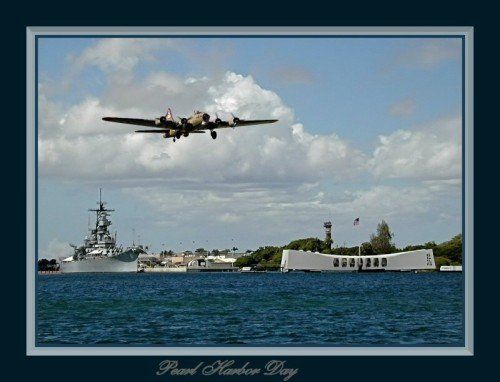
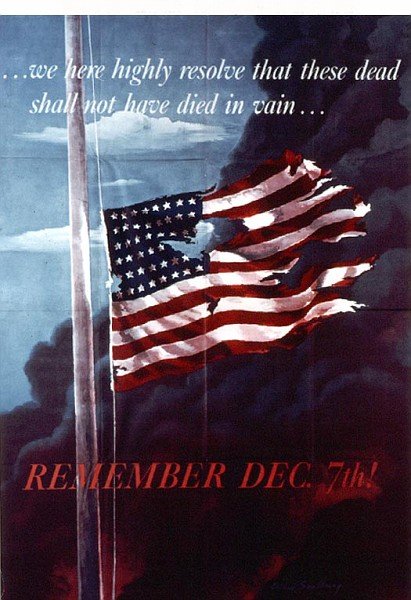
"A date which will live in infamy."
Honoring our veterans, praying
for the men and women
in Armed Forces currently defending
our freedoms at home and abroad.
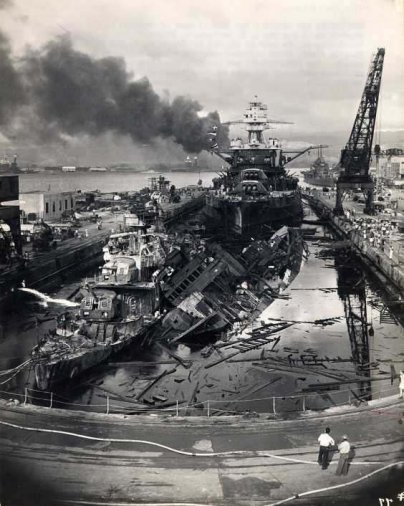
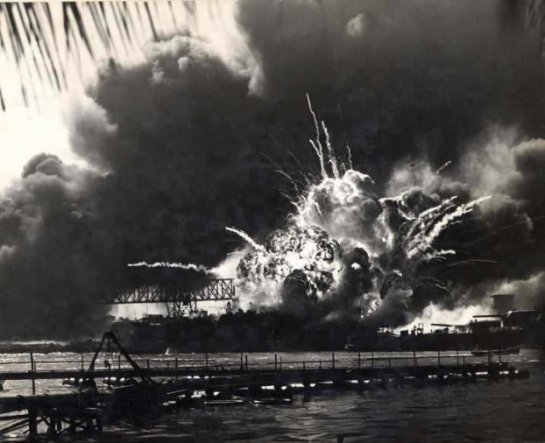
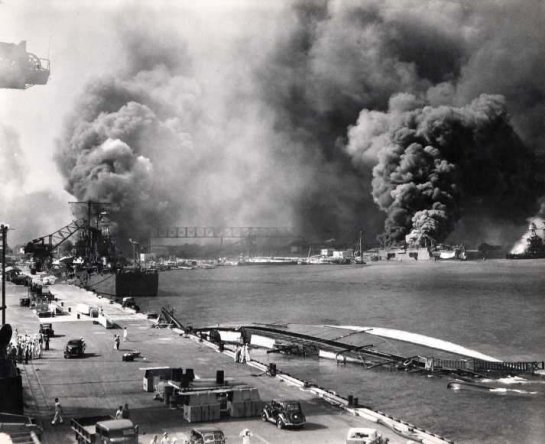
On Sunday, December 7th, 1941 the Japanese launched a surprise attack against the U.S. Forces stationed at Pearl Harbor, Hawaii . By planning his attack on a Sunday, the Japanese commander Admiral Nagumo, hoped to catch the entire fleet in port. As luck would have it, the Aircraft Carriers and one of the Battleships were not in port. (The USS Enterprise was returning from Wake Island , where it had just delivered some aircraft. The USS Lexington was ferrying aircraft to Midway, and the USS Saratoga and USS Colorado were undergoing repairs in the United States).
In spite of the latest intelligence reports about the missing aircraft carriers (his most important targets), Admiral Nagumo decided to continue the attack with his force of six carriers and 423 aircraft. At a range of 230 miles north of Oahu, he launched the first wave of a two-wave attack.
Beginning at 0600 hours his first wave consisted of 183 fighters and torpedo bombers which struck at the fleet in Pearl Harbor and the airfields in Hickam, Kaneohe and Ewa. The second strike, launched at 0715 hours, consisted of 167 aircraft, which again struck at the same targets. At 0753 hours the first wave consisting of 40 Nakajima B5N2 “Kate” torpedo bombers, 51 Aichi D3A1 “Val” dive bombers, 50 high altitude bombers and 43 Zeros struck airfields and Pearl Harbor.
Within the next hour, the second wave arrived and continued the attack.
When it was over, the U.S.losses were:
Casualties
USA : 218 KIA, 364 WIA.
USN: 2,008 KIA, 710 WIA.
USMC: 109 KIA, 69 WIA.
Civilians: 68 KIA, 35 WIA.
TOTAL: 2,403 KIA, 1,178 WIA.
Battleships
USS Arizona (BB-39) – total loss when a bomb hit her magazine.
USS Oklahoma (BB-37) – Total loss when she capsized and sunk in the harbor.
USS California (BB-44) – Sunk at her berth. Later raised and repaired.
USS West Virginia (BB-48) – Sunk at her berth. Later raised and repaired.
USS Nevada – (BB-36) Beached to prevent sinking. Later repaired.
USS Pennsylvania (BB-38) – Light damage.
USS Maryland (BB-46) – Light damage.
USS Tennessee (BB-43) Light damage.
USS Utah (AG-16) – (former battleship used as a target) – Sunk.
Cruisers
USS New Orleans (CA-32) – Light Damage..
USS San Francisco (CA-38) – Light Damage.
USS Detroit (CL-8) – Light Damage.
USS Raleigh (CL-7) – Heavily damaged but repaired.
USS Helena (CL-50) – Light Damage.
USS Honolulu (CL-48) – Light Damage.
Destroyers
USS Downes (DD-375) – Destroyed. Parts salvaged.
USS Cassin – (DD-372) Destroyed. Parts salvaged.
USS Shaw (DD-373) – Very heavy damage.
USS Helm (DD-388) – Light Damage.
Minelayers
USS Ogala (CM-4) – Sunk but later raised and repaired.
Seaplane Tender
USS Curtiss (AV-4) – Severely damaged but later repaired.
Repair Ship
USS Vestal (AR-4) – Severely damaged but later repaired.
Harbor Tug
USS Sotoyomo (YT-9) – Sunk but later raised and repaired.
Aircraft
188 Aircraft destroyed (92 USN and 92 Army Air Corps.)
Baker – Riyadh’s Man in Washington
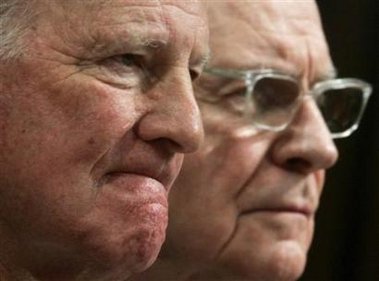
Co-chairmen of the Iraq Study Group former Secretary of State James Baker (L) and former Rep. Lee Hamilton (D-IN) hold a news conference on Capitol Hill, December 6, 2006. (Jim Young/Reuters)
IRAQ STUDY GROUP MEMBERS
All Intellectually and morally bankrupt. Nevil Chamberlin would be proud.
James Baker, co-chairman, Secretary of State under President Bush Sr
Lee Hamilton, co-chairman, ex-congressman (Democratic) who co-led 9/11 inquiry
Lawrence Eagleberger, Secretary of State under President Bush Sr
Vernon Jordan, adviser and gofer/golfer/pimp for the incidental “president” Clinton
Edwin Meese, Attorney General under President Reagan
Sandra Day O’Connor former Supreme Court justice
Leon Pannetta, Chief of Staff for President Clinton
William Perry, Defence Secretary under President Clinton
Charles Robb, former Senator (Democratic)
Alan Simpson, former Senator (Republican)

Wild Thing’s comment…..
Bakers surrender plan stinks to high heaven!
Baker, hand picked the people on this committee so he could control it, dealt Israel O U T? Baker is responsible for the Oslo Accords. That set up Israel for the damned Intifada. And here we go again…Baker is yet again trying to set Israel up for destruction/annihilation; Iraq too.
Baker has always been an “Arabist”. Baker wants Israel to cede the Golan Heights to Syria because he knows this will destroy Israel. Israel needs the Golan Heights as a buffer zone to keep Syria from cutting off Israel’s water supply. Baker obviously knows this but doesn’t care. Baker was Bush41’s Secretary of State and made the famous comment, “F_ _ _ the Jews,” regarding Israeli “intransigence” in surrendering to arafat’s intafada. Baker’s firm is representing the Saudi Regime AGAINST the families of victims of 9/11 in their lawsuit. Baker is determined to see the State of Israel eviscerated. It has been his goal for 20 years.
President Bush should stand up tall with his boots on and tell Baker to go F himself! Fight Back “W”…please! I pray Bush ignores this piece of garbage!
And another person I might as well add to my get lost list…..Gates! With his unanimous support of Senate Democrats behind his confirmation. I didn’t like most of his answers, I don’t like him! Gates would not get my vote.
If Bush accepts this plan, any part of it, and add in Gates, we are looking at This is an unmitigated disaster. imo
I hope he throws that Baker report in the trash.
And then of course this horrible person, Nancy Pelosi just can’t wait to spew the left’s agenda of their mantra that Bush lied.
(CNSNews.com) –
Nancy Pelosi, the incoming Democratic speaker of the House, on Wednesday praised the Iraq Study Group’s report on the Iraq war and said the report proves “that the President’s Iraq policy has failed and must be changed.”
UPDATE:
…Keep in mind though that Bush has not OK’d it as of right this minute. But this is the reaction of the terrorists about POS Bakers plan.
Terrorists rejoicing over new Iraq ‘plan’
Reaction to Study Group: ‘Allah and his angels’ responsible, ‘era of Islam and of jihad’ declared
JERUSALEM – A high level U.S. commission’s recommendations for an eventual withdrawal from Iraq and for dialogue with Iran and Syria proves “Islamic resistance” works and America will ultimately be defeated.
The militants, from the largest Palestinian terror groups in the Gaza Strip and West Bank, welcomed the policies outlined by the Iraq Study Group, which they claim recognizes Islam is the “new giant of the world.”
Rest of the article HERE
Pelosi To Put Dem Caucus Through Boot Camp
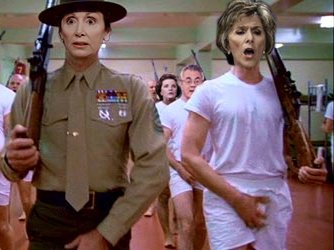
Pelosi to put Dem caucus through boot camp
Closed-door sessions will focus on foreign, economic policies
SFGate.com
Washington
Speaker-to-be Rep. Nancy Pelosi of San Francisco is taking her Democrats to school this week for discussions about Iraq and the domestic economy, even as the 109th Congress limps to the close of its four day “lazy duck” session this week.
The outgoing Republican-led Congress will leave behind a wealth of unfinished business for Pelosi and the other leaders of the new Democrat-controlled Congress, who promise a legislative blitz when they convene in early January.
The legislative highlights this week will be the expected Senate confirmation of Robert Gates as President Bush’s chosen replacement for Defense Secretary Donald Rumsfeld and an attempt to win House passage of a Senate-passed bill that would expand offshore oil drilling in the Gulf of Mexico west of Florida.
California’s two Democratic senators, Dianne Feinstein and Barbara Boxer, are pushing for last-minute passage of a compromise version of the Ryan White HIV/AIDS program reauthorization bill. It would prevent the most draconian cuts that earlier versions of the bill had in store for San Francisco.
Congress also will try to extend expiring tax breaks, including credits for sales tax payments and research and development breaks.
Having failed to finish work on nine of the 11 appropriations bills, totaling about $400 billion, Congress instead will pass a continuing resolution funding all federal activities, except for the already enacted military and homeland security spending bills, at current levels until mid-February of 2007.
That means that when the new Congress meets, it will have the unexpected responsibility, in addition to the busy 100-hour plan that Pelosi and new Senate Majority Leader Harry Reid of Nevada have proposed, of dealing with spending bills for all kinds of government programs, everything from national parks to aid to education to medical research.
The sputtering end for Congress led a Washington Post editorial Monday to label it the “lazy duck” session rather than the usual “lame duck.”
With the old Congress slowing down, Pelosi plans two closed-door sessions for Democratic members in an attempt to keep the spotlight on her party’s takeover, which begins Jan. 4.
Democrats are scheduled today to hear from foreign-policy experts on Iraq, including former President Jimmy Carter’s national security adviser Zbigniew Brzezinski, former President Bill Clinton’s U.N. Ambassador Richard Holbrooke and retired Army Gen. John Batiste, a leading critic of President Bush’s Iraq policy.
On Wednesday, the Democrats will meet with Robert Rubin, Clinton’s treasury secretary and a top Wall Street figure, to discuss the economy.
The Iraq discussion comes just a day before the Iraq Study Group releases its report that is likely to recommend stepped-up training of Iraqi forces and a withdrawal of some U.S. forces from the country. The recommendations are unlikely to win favor with some in the Democratic House caucus who want a quick start to troop withdrawals.
The choice of Rubin for an economic discussion is interesting. He helped steer the nation into a budget surplus in Clinton’s last term, a position that is popular with many of the deficit-hawk incoming Democrats. But he is also an advocate of free trade, an unpopular position with many House freshmen elected from districts in states such as Indiana, Ohio or Pennsylvania that have lost manufacturing jobs to such low-wage countries as China.
A lively discussion with Rubin is expected. “We welcome dissent and differing opinions in the Democratic caucus,” Crider said.
Later in the week, the Democratic House Steering and Policy Committee is expected to approve the Pelosi-backed lineup of committee chairmen in the coming Congress. No surprises are expected, now that she has tapped Rep. Silvestre Reyes, D-Texas, to chair the House Intelligence Committee. That ended the one bit of suspense in the committee picks, because Pelosi passed over the current panel’s two top Democrats before settling on Reyes, a 26-year veteran of the Border Patrol.
Bay Area chairmen will include Rep. Tom Lantos, D-San Mateo, at International Relations; and Rep. George Miller, D-Martinez, who will lead the Education and Work Force Committee.
The 109th Congress’ failure to pass most of the appropriations bills presents the Democrats with an opportunity and a burden.
The unfinished bills contain thousands of earmarks, the controversial individual spending items that members insert at the last minute, skirting the usual oversight of the congressional committee system. In the unfinished bills, such earmarks add up to tens of billions of dollars and have drawn sharp criticism from government watchdog groups.
By not approving the bills, the Republicans pass the ball to the Democrats, who next year can decide to pass the spending bills as is, or strip out the earmarks, or combine all the appropriations bills into a single omnibus bill.
“The Democrats may do an omnibus and have no obligation to include the earmarks,” said Steve Ellis of Taxpayers for Common Sense.
Ellis was scornful of the GOP Congress. “The failure to do these bills is the biggest indictment of incompetence in the 109th Congress,” he said. “They have one major constitutional responsibility (to raise money and spend it), and they couldn’t do it.”
Earmark-reform legislation, which at a minimum would disclose the sponsors of all such items, is among the top issues Democrats plan to take up in January. Therefore, it would seem impossible for them to turn around and quickly pass spending bills containing thousands of earmarks.

Wild Thing’s comment…..
When I saw what they titled this article the Dems it made me angry. I hate when the cowardly left uses military lingo for things when they hate our military so much.
So in the graphici I have for this you see them in bootcamp including Bawney Fwank! heh heh
Another Do As I Say Or You Will Be Dead from little man on footstool
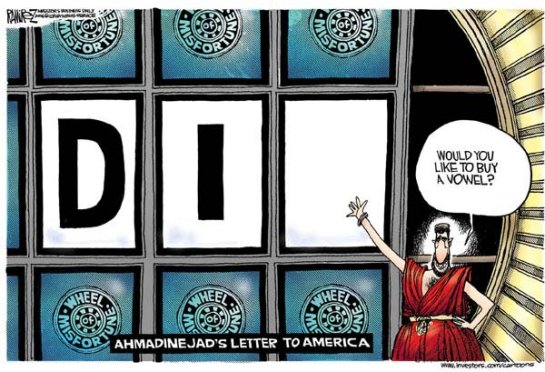
Follow God or vanish, Ahmadinejad tells West
Breitbart
Iranian President Mahmoud Ahmadinejad has warned Western leaders to follow the path of God or “vanish from the face of the earth”.
“These oppressive countries are angry with us … a nation that on the other side of the globe has risen up and proved the shallowness of their power,” Ahmadinejad said in a speech in the northern town of Ramsar, the semi-official news agency Mehr reported Wednesday.
“They are angry with our nation. But we tell them ‘so be it and die from this anger’. Rest assured that if you do not respond to the divine call, you will die soon and vanish from the face of the earth,” he said.
The outspoken president also maintained Iran’s defiance over its controversial nuclear programme, saying it was on course to fully master nuclear technology.
“Thank to God’s help, we have gone all the way and are only one step away from the zenith.
“We hope to have the big nuclear celebration by the end of the year (March 2007),” Ahmadinejad said, echoing comments he has made on numerous occasions in recent months.

Wild Thing’s comment……
So he says we either convert to Islam or he will kill us. I expect that prayer rugs and Korans will be soon handed out by the appeasers of the Baker (the POS that he is!) Commission and the Democrats in Congress. Or maybe our weak leaders will rush Jimmy Carter and James Baker over there for a sit down with this creep in Iran.
Clueless Americans, that have consciously chosen to ignore the fact that our enemies want us dead, better wake up like yesterday. Pelosi and the Liberals have their heads up their rears. When we get attacked again, it will be their fault along with Jimmah Carter, Howard Baker, and all RINOs.
And here is a newsflash for you Monkeyboy!! Your god is a moon god, no more powerful then your daily horoscope you freakazoid!
Homegrown Terrorists Recruited to Attack America
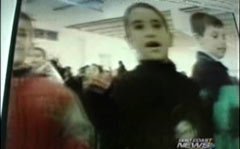

Homegrown Terrorists Recruited to Attack America
JACKSONVILLE, FL
It’s a video showing a room full of children sharing their dreams. They are not excited about being doctors, lawyers or teachers. Instead, the children shout, “We are the nation of Hezbollah. I shall sacrifice my life for Allah.”
A group of children in training to be a mujahideen, or holy warrior.
Online there are videos of those warriors. One suicide bomber announces he is readying himself to blow up a group of American soldiers.
The video goes on for eight minutes and even shows the explosion. In the background are cheers from those taking the pictures.
The video is just some of the many the First Coast News I-team found on the internet from sites like Youtube and Myspace.
“I think right now we are a ticking time bomb,”says Tom Hayden, a retired Lt. Col Marine, who is also a counter terrorism expert.
Hayden says some of the videos, while disturbing, are online for a reason.
“Something like myspace, probably the most well known, popular website right now, it’s even being used to transmit messages,” says Hayden.
He says there are messages left on the internet for those recruited to carry out another 9/11 type attack. Hayden says those Jihad soldiers are getting messages in chat rooms and on message boards.
“There is a specific time that a message is coming. Then it’s on there and then it is taken off,” says Hayden.
He says hidden messages are also being sent in pictures and videos and the solider is already equipped with the code to unlock the secret. “It’s being used quite frequently.”
In fact, some of the videos we found and recorded were gone in a matter of days, removed by the user.
There was no trace of what was there or who the page belonged to. The experts will tell you that’s a problem, because there is a new breed of terrorist out there.
“You won’t see anymore like we have Mohammad Atta and that group that came,” says Hayden.
The Federal Bureau of Investigation agrees, saying the internet has created a series of new problems.

Wild Thing’s comment……
The actual video was not with the article, but the photo at the top is from the video according to the write up. I do believe there is a new breed of terrorists coming along. They have thought of everything when it comes to propaganda, teaching the young and getting the word out.
Happy Birthday SondraK
Happy Birthday

Thank you for your kindness and friendship. Have a wonderful and special birthday!
Love
Chrissie
And everyone here!
Clinton Pays Tribute to Ho Chi Minh at Mausoleum
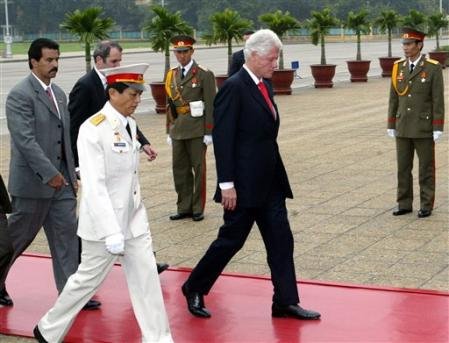
Former U.S. President Bill Clinton goes to pay tribute to late Vietnamese revolutionary leader Ho Chi Minh at his mausoleum in Hanoi, Vietnam, Wednesday, Dec. 6, 2006. Clinton came to Hanoi to sign an agreement with the Vietnamese government under which his Clinton Foundation will provide pediatric drugs to children living with HIV and AIDS. (AP Photo/Tran Van Minh) Email Photo Print Photo
Former U.S. President Bill Clinton goes to pay tribute to late Vietnamese revolutionary leader Ho Chi Minh at his mausoleum in Hanoi, Vietnam
HANOI, Vietnam (AP) – Former President Clinton was swarmed for autographs, handshakes and photographs on the streets of Hanoi Wednesday by throngs of admirers whose warm welcome contrasted sharply with the restrained reception given President Bush last month.
Clinton, in town to sign an agreement between his foundation and the Vietnamese to get more AIDS drugs to children, left the Hilton Hotel in the center of Hanoi, crossed an intersection buzzing with motorbikes, and strolled toward Hoan Kiem Lake, the spiritual heart of the city.
“It feels great to be back,” Clinton said as he set off for his stroll.
Followed by Secret Service agents and Vietnamese police, Clinton stopped along a half-mile route to chat with his Vietnamese admirers before making his way to an art gallery in Hanoi’s Old Quarter and then to the tomb of Ho Chi Minh, who led Vietnam’s communist revolution.

Wild Thing’s comment……
So communist Clinton pays tribute to the man he was routing for during the war. I’m so sick of US leaders who pay tribute to the worst jackals of the world! The communists know their won kind.
A wonderful world we live in where ruthless dictators are praised and protected, dishonest heads of state are lionized and honest men who act only for the good of their nations are belittled and scorned.
I can’t stand these traitors, Clinton, Carter, Gore, Kerry etc. I am sick of this shit! Hey Clinton just stay in Nam why don’t you.
“Werewolves” Carry Out Same Mission 41 Years Later
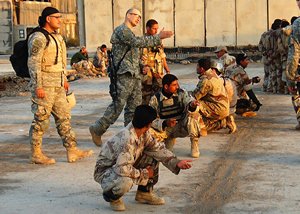
Soldiers from 4th Battalion, 31st Infantry Regiment, 2nd Brigade Combat Team, 10th Mountain Division and 4th Battalion, 4th Brigade, 6th Iraqi Army Division go through dry runs and other training before their air assault mission. Later that night, after being flown in by 3-227th the Soldiers would storm Qarghuli Village looking for insurgents known to be hiding out. (U.S. Army Photo by Capt. Christopher Sanchez, 4-31st, 2nd Brigade Combat Team, 10th Mountain Division)
“Werewolves” Carry Out Same Mission 41 Years Later
By Spc. Nathan J. Hoskins, 1st Air Cavalry Brigade Public Affairs
CAMP TAJI, Iraq
They say history is written by the victorious. That’s why for 41 years the 1st Cavalry Division has been writing the history of air assaults.
Soldiers of 3rd Battalion, 227th Aviation Regiment, 1st Air Cavalry Brigade, are carrying on the air assault mission, which started Nov. 14, 1965 in the Ia Drang Valley of Vietnam.
As told in the book, “We Were Soldiers Once … and Young,” and later as a feature film, it was 41 years ago when Lt. Col. Hal Moore took the grounds of Landing Zone X-Ray with Soldiers of 1st Battalion, 7th Cavalry Regiment, 1st Cavalry Division, and started what would be the newest and most innovative way to place Soldiers on the battlefield – by helicopter.
On that same day 41 years later, aviators from 3-227th carried on the traditions of the 1st Cavalry Division’s air units with their first air assault mission since hitting the grounds in Iraq. The Company A “Werewolves” dropped off infantry Soldiers ready to carry out their mission to seek out and capture insurgents.
From the humble beginnings of a young, newly created unit, to training and heading straight into combat, 3-227th and 1/7th share an uncanny resemblance, said Capt. Lee Evans, commander of the Werewolves.
Like the 1/7th four decades ago, 3-227th stood up as a unit shortly before deploying.
“We were given less than six months when we were formed as a battalion [before heading to Iraq], and even then we weren’t completely formed,” said Evans.
Not long after 1/7th “Air Cav” became reorganized – and lost some of its more experienced men – it headed off to Vietnam. This made the unit smaller and less experienced.
The 1/7th Cav, as a complete unit, was not in country for more than a month when the order came down to take the Ia Drang Valley. It did not matter how experienced or inexperienced a Soldier was, there was a job to be done.
Much like the 1/7th Cav, 3-227th was reorganized quickly and had many inexperienced pilots in regards to air assaults, said Evans.
“A lot of people in our unit came from general support battalions, which still conduct air assaults, but it isn’t their bread and butter,” Evans said.
But the aviators of 3-227th, quickly became familiar with air assaults through rigorous training when they headed to the National Training Center at Fort Irwin, Calif., and also to the Joint Readiness Training Center at Fort Polk, La. – both training areas where Soldiers go to ready themselves for battle, said Evans.
With less than six months under their belts as a unit, two of those training at NTC and JRTC, the Soldiers of 3-227th quickly cased their colors and headed to the Middle East.
Some aspects of this first air assault are familiar in regards to what their predecessors faced on the grounds of LZ X-Ray, said Brunswick, Maine, native 1st Lt. Douglas Livermore, a plans officer for 4th Battalion, 31st Infantry Regiment, 2nd Brigade Combat Team, 10th Mountain Division “Polar Bears.”
“We were air assaulting into an isolated and alien environment, far from possible help from our comrades. We had to rely on each other and our training to accomplish the mission and get everyone home,” he said.
Livermore’s words echoed those of a historic quote from Moore, on the subject of Soldiers relying on each other.
“American Soldiers in battle don’t fight for what some president says on T.V., they don’t fight for mom, apple pie, the American Flag … they fight for one another,” said Moore.
After being inserted into their LZ, the ground troops, a mix from 4-31st and 4th Battalion, 4th Brigade, 6th Iraqi Army Division, led by Iraqi Army Capt. Ibraheim Jmile Abed, would go on to clear multiple houses in the dead of night, routing any insurgents hiding in Qarghuli Village, said Capt. Christopher Sanchez, the non-lethal coordinator for 4-31st.
For those who jump out into the fray of danger and uncertainty, a lot has changed since Vietnam. In Iraq, the enemy is not gathered in force as it was in the North Vietnamese Army.
“While the Soldiers of 1/7 CAV faced challenges more intense in terms of sheer violence, we have been forced to deal with an opponent who uses stealth and deceit to avoid our advantages. Not to detract from their battle, but ours has greater complexity due to the multiple facets involved,” said Livermore.
“In Vietnam the fight was similar [to Iraq] in that they had some insurgency where the enemy didn’t have a uniform, but there was a much more concerted effort to stand up to us – to face us,” said Missoula, Mont., native Chief Warrant Officer 2 Emmanuel Vero, a UH-60 Black Hawk pilot for Company A, 3-227th.
Things have also changed for the pilots and crews of the aircraft since 1965, in regards to the basic concept of air mobile, in the technology used and in the combat seen, said Evans.
During the Vietnam conflict, groups the size of battalions were moved into locations to fight battles. Now units the size of companies or smaller are strategically placed to accomplish a specific mission, said Evans.
“Air Assaults take [the air mobility concept] a little bit further … it’s more of a combined arms effort … the element of surprise is essential,” said Evans.
With the more powerful helicopters, aviators of today have an advantage over the UH-1 Iroquois “Huey” pilots of Vietnam, Evans said.
The speed and agility of the Black Hawk supersedes that of the Huey, and aviators now have the innovation of night vision enabling them to move stealthily towards and away from target landing zones, he said.
Although dangerous, the Polar Bears take advantage of the night insertions and are energized with their precarious mission.
“It is always exciting to fly blacked out, landing in [an] area known not to be safe and watching your ride fly away,” said Maj. Robert Griggs, the 4-31st operations officer.
One evident difference between the fight fought in the Ia Drang Valley and the one presently in Iraq is the stressors of such a high casualty count, said Vero.
“To every day be responsible to go in against an actual military force is something we don’t do … (the enemy in Vietnam) wasn’t an insurgency, it wasn’t a group of farmers with guns; that was a well trained, well organized military,” said Vero.
“What we have [in Iraq] are almost more like thugs. I don’t give them the same respect. They don’t have the courage to wear a uniform or stand for what they believe in,” he said.
The fight that the Soldiers, ground and aviators alike, have to face now pales in comparison to the fight that those men took on in the Ia Drang Valley, said Vero.
“The date was the same; the mission was a lot different. Those men – I would have to stand on a ladder to touch their shadow; they’re kind of above and beyond me,” Vero said in reflection.
With an impressive history and lineage behind them, Soldiers of 3-227th feel they have done well in honoring the memory of those who came before them, said Evans.
“In trying to uphold that lineage, if [the veterans of LZ X-Ray] could have seen what happened over here on the 14th of November, I think they would’ve been proud that we were able to accomplish the mission in the manner that we did,” he said.
“We did well on making the LZ that night, but honestly, the only standard that we can be held to is that everyone
got in there safely and everyone got out of there safely and those are the numbers we really care about,” said Vero.
Although the pilots get them to their designated place at the designated time, they have respect for the ground units’ valor in such a dangerous job, said Vero.
“At the end of the day, we’re doing eight minutes in danger and they’ve got 50 hours to look forward to. We are just a small sliver of their day. If we can make that small sliver any better or safer for them, then that’s an honor for us,” he said.
And it all boils down to completing the mission, one that aviators of 3-227th are proud of. One that has lasted for 41 years and continues this day with the same unit it began with – the “Air Cav.”
“This isn’t what we do for a living; this is our life’s work. You will only find that in people who take their personal military profession to heart,” Vero said. “Every one of these guys are my brothers – I’m just proud to be apart of the Alpha Company Werewolves.”
Muslim Woman Whine For Cash

Muslim woman cites gym after interrupted prayer
Dearborn resident says her complaint to Fitness USA manager about patron went unheeded.
Gregg Krupa /
The Detroit News
DEARBORN — Fitness USA, a gym chain, is investigating an alleged civil rights violation involving a local Muslim woman who says her afternoon prayer was interrupted by a fellow patron, and that her complaint to management about the situation was rejected.
“The manager told me, ‘You have to respect her (the patron), but she does not have to respect your God,'” said Wardeh Sultan of Dearborn. “I’ve had my membership for seven or eight years, and I’ve never had a problem with praying there.
“I told that manager, ‘I can’t believe you said that’ ” Sultan said. “Honestly, I feel humiliated and I feel ashamed, right now, to go back to Fitness USA.”
Local representatives of Fitness USA, which operates branches throughout Metro Detroit and in two other states, referred all inquiries regarding the matter to their corporate offices.
“We will, as we will with any complaint involving our staff and a member, be doing a full and thorough investigation of the matter and take any appropriate action we need to take,” said Jodi Berry, executive director of Fitness USA. “We want every member to get a good exercise experience every time they come to the club.”
Berry said she learned of the complaint on Monday.
The allegations are among a series of recent complaints by Muslims who say they are free to practice their religion in the United States, until someone tells them they cannot. Recently, the same Fitness USA facility enacted a new dress code to allow Muslim women to wear more modest clothing, in compliance with some Islamic practices.
Two weeks ago, six Muslim clerics were removed from a U.S. Airways flight after three of them said their evening prayers in the St. Paul-Minneapolis International Airport.
Passengers and employees of the airline said later that their suspicions were aroused when the men were overheard making comments critical of the United States, and because the men had one-way tickets and no baggage.
The airline and the civil rights office of U.S. Department of Homeland Security are investigating that incident.
Imad Hamad, regional director of the American Arab Anti-Discrimination Committee, which lodged a formal complaint with Fitness USA on behalf of Sultan, said the recent spate of conflicts results from a growing intolerance of Islam and a growing restiveness among Muslims that their rights to speak freely and worship are increasingly at risk.
“They (Muslims) are resenting that they are to be suppressed from expressing themselves freely, like others,” Hamad said.
“It’s OK for a Christian fellow or a Jewish fellow to pray, and it would be regarded highly and respected. When it comes to a person of Muslim faith, especially if a woman is wearing the head cover or a man with a typical clergy outfit, yeah, it is becoming like something that is offensive to people and making them nervous.”
Sultan said that, like all pious Muslims, she prays five times daily. She also wears a veil and a long dress, in observance of her faith.
Born in Jordan, of Palestinian descent, Sultan arrived in Detroit 17 years ago, before moving to Dearborn. She is an American citizen.
Sultan said she came to the United States to secure her freedom and to avoid intolerance.
“We’re here in the great United States and for this happening, it truly breaks my heart,” she said. “You know, things are starting to change backwards, instead of frontward. We need to keep this United States, our country, up on our shoulders. We don’t want it to go down.”
UPDATE since the story was written above:
Wardeh Sultan, the Palestinian Muslim chick, got in the way in the women’s locker room and picked a fight with the women trying to get around her.
It appears that Sultan objected to other gym members’ exercise of free speech. It also appears that the whiny Muslim chick refused to identify herself to gym management and was being so disruptive, she was asked to leave and the police were called. The police arrived and questioned Sultan, and she was forced to leave.
And it looks like from the language used (“claimant”) that lawyers are already involved and a lawsuit is already being prepared:
ADC Michigan Concerned with Allegations Against Fitness USA
ADC Michigan is seriously concerned with a number of complaints that have been filed at its office, against Dearborn Fitness USA. Most recently, two female Muslim members were harassed by patrons and Fitness staff as they attempted to pray in the locker room. According to the information that ADC has received from the claimants and witnesses, the women were praying near the lockers when another patron began to make remarks and proceeded to push them. One of the claimants reported the incident. However, according to the claimant, the desk manager, rather than address the matter professionally, told the claimant that “she does NOT HAVE to respect your God, but you HAVE to respect her.” She then proceeded to ask the claimant for her card.
The claimant told the manager that she has done nothing wrong and refused to give her the card in fear of what she may do with it. The manager subsequently called the police and stated the claimant was “creating a disturbance and was asked to leave.” The claimant explained that she had not yelled, threatened, touched, or caused a disturbance, but rather brought the matter to the attention of the manager to explain what had happened to her. After being questioned by the police, the claimant left feeling fearful, humiliated and discriminated against. ADC Michigan is concerned with the inappropriate and unprofessional manner that this matter was handled and has requested that this matter is immediately addressed.

Wild Thing’s comment……..
Back in April I posted this ……..200 Burka Babes Take On Fitness Gym….. The women, Arrwa Mogalli and Ammerah Saidi, got their wish from doing their whine to the media and Islamic “civil rights” groups.
Well the Burka babes are at it again with this woman and her whine about her prayer being interrupted at a gym no less. And also please not how the writer of this article has his own slant on his pro Islam point of view.
And ever notice that their “offense” can be mollified by cold hard cash????
It is by design. They are testing, pushing. Look at how they have nearly consumed Europe. Look at Britain having areas controlled by Sharia law.
They are using our freedoms against us, to the point where religion will be THE dividing factor in this country- not race. Their goal is to abolish the Constitution. Period. And their so-called religion is not even a religion but a death cult so vile, horrible and destructive. It is not only a religion to the followers but the law they live under as well. Our laws are secondary if that to what they live by.
They are probing and pushing to see how far they can go before we snap. So far they have been incredibly successful in getting their way. They are learning that Americans are jellyfish without any will of their own. And we laugh at Europe? Our demise is right around the corner and we can’t even get our citizens to elect people who will fight rather than appease the enemy. We’re toast.

Recent Comments